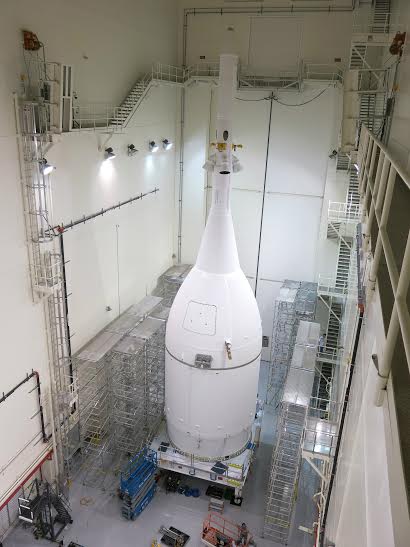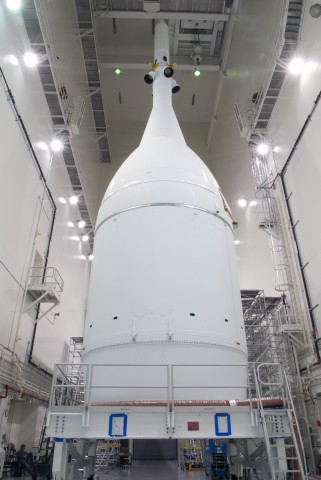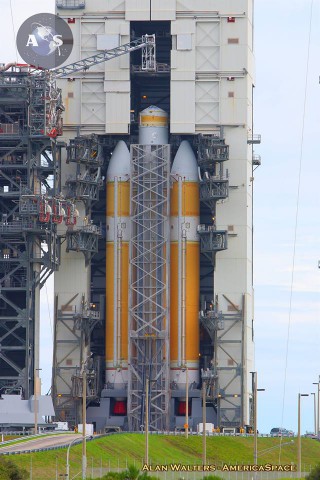
In less than a month, after years of work from thousands of people spread across the country, NASA’s Orion deep space crew capsule will make its way to space atop America’s largest and most powerful rocket, the United Launch Alliance Delta-IV Heavy, and now that the spacecraft is complete all systems are GO to roll Orion out from Kennedy Space Center’s Launch Abort System Facility to nearby Space Launch Complex-37 at Cape Canaveral Air Force Station to meet its rocket for a scheduled Dec. 4 sunrise launch.
“An empty shell of a spacecraft arrived to Kennedy Space Center two years ago, and now we have a fully assembled Orion standing 72 feet tall,” said Michael Hawes, Lockheed Martin Orion program manager. “We’re ready to launch it into space and test every inch.”

With assembly, fueling, and testing of the spacecraft now complete, the focus has turned to transporting Orion safely to the launch pad Monday evening, Nov. 10. Technicians with Lockheed Martin, Orion’s prime contractor, have already placed the spacecraft into its proper orientation atop its transport pallet for mating with the Delta-IV Heavy launcher, which was followed by a fairing purge test to verify how much dry gas needs to be pumped into the space between Orion’s Ogive panels (which protect Orion from harsh vibrations during launch) and the spacecraft. The dry gas ensures that when Orion is transported it won’t trap moisture, which could cause corrosion and contamination.
Orion is scheduled to begin its slow six-hour trip to nearby SLC-37 at 8:00 p.m. EDT on Nov. 10, arriving to meet its mammoth launch vehicle at 2:00 a.m. EDT on Nov. 11. Once Orion arrives, plans call to immediately begin the delicate process of lifting the spacecraft 170 feet in the air for stacking on top of the Delta-IV Heavy, and over the next few weeks both the rocket and Orion will be integrated and powered up, and interfaces between the two will be verified in preparation for the upcoming high-profile launch.
The rocket itself arrived at the launch pad Sept. 30 to begin performing extensive launch vehicle readiness testing, and earlier this week ULA successfully conducted a Wet Dress Rehearsal, fueling the giant rocket with liquid Hydrogen and liquid Oxygen for a practice countdown ahead of Orion’s arrival next week.
The Heavy rocket, tasked with launching Orion on its unmanned flight test, is exactly the same as has been flown by ULA seven times previously, and so processing of the three impressive 133-foot-long common core boosters (testing, checkout verifications, etc.) and the rocket’s second stage was standard operations for ULA. However, the Orion payload is unique; its larger than the top-secret classified government satellites the Heavy is usually responsible for launching. Its payload fairing is taller and has a larger diameter than what SLC-37’s Mobile Service Tower (MST) can accommodate, and so ULA has made several modifications to the MST in recent months to support processing Orion for its December flight.

“This is a big deal for us, Orion is the product of a very dedicated workforce that believes keeping America first in space exploration is critical,” said Orion Program Manager Mark Geyer. “This flight, not just the launch in Dec. but the work that went into this design, sets us up very well for the next flights, and for eventually getting people into space again.”
The upcoming 4.5-hour unmanned flight test will put the entire state-of-the-art spacecraft in action to validate all of its systems and hardware operate correctly in-flight (computers, software, guidance and control, the separation events, the heat shield, and parachutes). After the first orbit (two hours after liftoff) the vehicle will perform a burn to reach an altitude of more than 3,600 miles—15 times higher than the orbit of the International Space Station and 10 times higher than any human-rated spacecraft has been since 1972, when the crew of Apollo 17 visited the Moon. Orion will then detach from the Delta-IV upper stage and re-enter the Earth’s atmosphere at more than 20,000 mph—nearly 5,000 mph faster than the space shuttle—before parachuting gently into the Pacific Ocean off the coast of southern California. The U.S. Navy will be standing by for recovery.
The data gathered during the mission will influence design decisions and validate existing computer models, as well as help to reduce overall mission risks and costs for future Orion flights atop NASA’s huge Space Launch System (SLS) Mars rocket, the first of which is already being built for an inaugural test launch “No Later Than” November 2018.
Liftoff of Orion on EFT-1 is currently scheduled for 7:04 a.m. EDT Dec. 4, with the launch window extending to 9:44 a.m. EDT.
AmericaSpace is, as always, providing on-site coverage of Orion’s EFT-1 mission, follow our EFT-1 MISSION UPDATES page and check back regularly for updates.
Want to keep up-to-date with all things space? Be sure to “Like” AmericaSpace on Facebook and follow us on Twitter: @AmericaSpace
Missions » SLS » EFT-1 »



